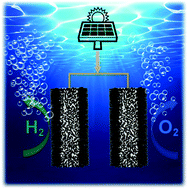Self-supported and defect-rich CoP nanowire arrays with abundant catalytic sites as a highly efficient bifunctional electrocatalyst for water splitting†
Abstract
It is an indisputable fact that electrocatalytic activity is always improved by introducing defects into nanomaterials. Thus, this study demonstrates a simple strategy for a defect-rich and porous cobalt phosphide nanowire array electrocatalyst derived from a MOF material on a nickel foam, which drives water splitting well in alkaline media. Excitingly, p-CoP/NF shows an excellent catalytic performance toward the hydrogen evolution reaction with an ultralow overpotential of 35 mV to achieve 10 mA cm−2. Similarly, it is capable of the oxygen evolution reaction and reaches a current density of 10 mA cm−2 with an overpotential of 253 mV. Furthermore, when the anode and cathode of a two-electrode electrolytic cell are both assembled from p-CoP/NF electrodes, this cell requires a voltage of only 1.55 V to afford a current density of 10 mA cm−2 and exhibits satisfactory durability, which fully demonstrates the potential application of p-CoP/NF electrodes for water splitting.



 Please wait while we load your content...
Please wait while we load your content...